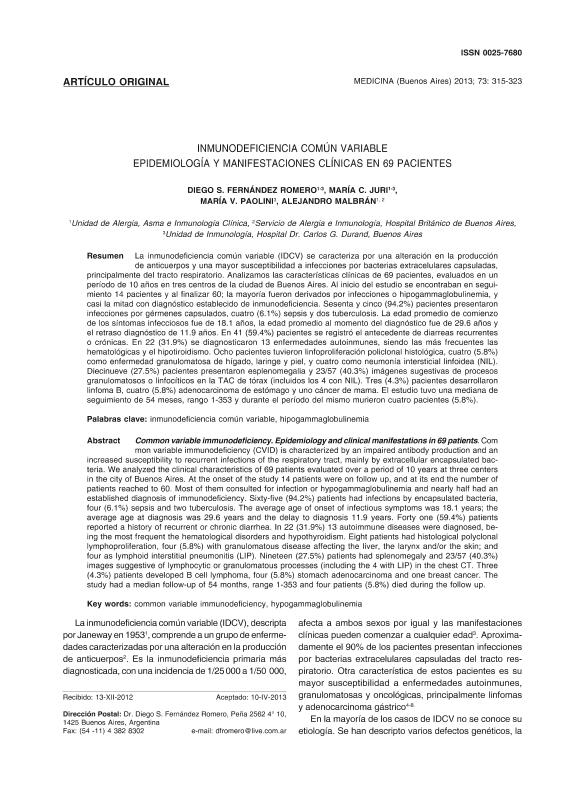Artículo
La inmunodeficiencia común variable (IDCV) se caracteriza por una alteración en la producción de anticuerpos y una mayor susceptibilidad a infecciones por bacterias extracelulares capsuladas, principalmente del tracto respiratorio. Analizamos las características clínicas de 69 pacientes, evaluados en un período de 10 años en tres centros de la ciudad de Buenos Aires. Al inicio del estudio se encontraban en seguimiento 14 pacientes y al finalizar 60; la mayoría fueron derivados por infecciones o hipogammaglobulinemia, y casi la mitad con diagnóstico establecido de inmunodeficiencia. Sesenta y cinco (94.2%) pacientes presentaron infecciones por gérmenes capsulados, cuatro (6.1%) sepsis y dos tuberculosis. La edad promedio de comienzo de los síntomas infecciosos fue de 18.1 años, la edad promedio al momento del diagnóstico fue de 29.6 años y el retraso diagnóstico de 11.9 años. En 41 (59.4%) pacientes se registró el antecedente de diarreas recurrentes o crónicas. En 22 (31.9%) se diagnosticaron 13 enfermedades autoinmunes, siendo las más frecuentes las hematológicas y el hipotiroidismo. Ocho pacientes tuvieron linfoproliferación policlonal histológica, cuatro (5.8%) como enfermedad granulomatosa de hígado, laringe y piel, y cuatro como neumonía intersticial linfoidea (NIL). Diecinueve (27.5%) pacientes presentaron esplenomegalia y 23/57 (40.3%) imágenes sugestivas de procesos granulomatosos o linfocíticos en la TAC de tórax (incluidos los 4 con NIL). Tres (4.3%) pacientes desarrollaron linfoma B, cuatro (5.8%) adenocarcinoma de estómago y uno cáncer de mama. El estudio tuvo una mediana de seguimiento de 54 meses, rango 1-353 y durante el período del mismo murieron cuatro pacientes (5.8%). Common variable immunodeficiency (CVID) is characterized by an impaired antibody production and an increased susceptibility to recurrent infections of the respiratory tract, mainly by extracellular encapsulated bacteria. We analyzed the clinical characteristics of 69 patients evaluated over a period of 10 years at three centers in the city of Buenos Aires. At the onset of the study 14 patients were on follow up, and at its end the number of patients reached to 60. Most of them consulted for infection or hypogammaglobulinemia and nearly half had an established diagnosis of immunodeficiency. Sixty-five (94.2%) patients had infections by encapsulated bacteria, four (6.1%) sepsis and two tuberculosis. The average age of onset of infectious symptoms was 18.1 years; the average age at diagnosis was 29.6 years and the delay to diagnosis 11.9 years. Forty one (59.4%) patients reported a history of recurrent or chronic diarrhea. In 22 (31.9%) 13 autoimmune diseases were diagnosed, being the most frequent the hematological disorders and hypothyroidism. Eight patients had histological polyclonal lymphoproliferation, four (5.8%) with granulomatous disease affecting the liver, the larynx and/or the skin; and four as lymphoid interstitial pneumonitis (LIP). Nineteen (27.5%) patients had splenomegaly and 23/57 (40.3%) images suggestive of lymphocytic or granulomatous processes (including the 4 with LIP) in the chest CT. Three (4.3%) patients developed B cell lymphoma, four (5.8%) stomach adenocarcinoma and one breast cancer. The study had a median follow-up of 54 months, range 1-353 and four patients (5.8%) died during the follow up.
Inmunodeficiencia Común Variable. Epidemiología y manifestaciones Clínicas en 69 pacientes.
Título:
Common variable immunodeficiency. Epidemiology and clinical manifestations in 69 patients.
Fecha de publicación:
04/2013
Editorial:
Medicina (buenos Aires)
Revista:
Medicina (buenos Aires)
ISSN:
0025-7680
e-ISSN:
1669-9106
Idioma:
Español
Tipo de recurso:
Artículo publicado
Clasificación temática:
Resumen
Palabras clave:
Inmunodeficiencia
,
Hipogammaglobulinemia
,
Cvid
Archivos asociados
Licencia
Identificadores
Colecciones
Articulos(SEDE CENTRAL)
Articulos de SEDE CENTRAL
Articulos de SEDE CENTRAL
Citación
Fernández Romero, Diego S.; Juri, María C.; Paolini, María V.; Malbran, Alejandro; Inmunodeficiencia Común Variable. Epidemiología y manifestaciones Clínicas en 69 pacientes.; Medicina (buenos Aires); Medicina (buenos Aires); 73; 4; 4-2013; 315-323
Compartir




